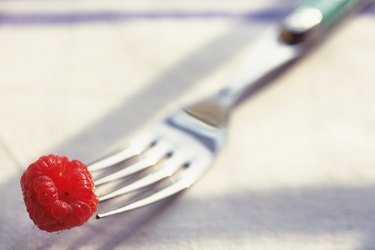
The sight of blood in your stool can be alarming. Common causes, however, such as constipation and hemorrhoids, are typically mild and no cause for alarm. A nutritious, fiber-rich diet can help manage or prevent your symptoms. Discuss dietary changes with a qualified health-care professional for best results. Because bloody stools can derive from serious diseases, however, seeking guidance from your doctor is recommended, particularly if your symptoms are severe or long-lasting.
Fiber Benefits
Video of the Day
Americans, as a whole, consume too little fiber, averaging 5 to 14 g per day, according to the National Digestive Diseases Information Clearinghouse, or NDDIC. Because fiber promotes soft, bulky, easy-to-pass stool, a high-fiber diet lowers your risk for bloody stool related to constipation and hemorrhoids. If you are constipated, you have infrequent bowel movements or hard, small stools. Hemorrhoids are swollen veins in or just outside your anus. Eating plenty of fiber can guard against pain and worsened symptoms by ensuring soft, passable stool.
Video of the Day
Helpful Foods
Fiber occurs naturally in plant-based foods, including whole grains, nuts, seeds, legumes, fruits and vegetables. Most women should aim for 25 gram of fiber per day, while men should aim for 38 grams. Particularly rich fiber sources include cooked beans, lentils and split peas, which supply 15 to 16.5 grams per cup; fresh raspberries, which provide 8 grams per cup; and artichokes, which contain 10.3 grams each. Oats, barley, popcorn, dark green vegetables and pears are also fiber-rich.
Foods to Avoid
No foods are known to cause bloody stools or related conditions. Eating too many low-fiber foods, however, leaves little room in your diet for helpful fare. To ensure plentiful whole grain intake, substitute white rice, which is a refined grain, with whole grain brown rice in your favorite recipes. Other low-fiber foods worth limiting include enriched white and wheat bread, conventional pasta, candy and low-fiber cereals, such as puffed rice or wheat.
Additional Diet Suggestions
Deficient fluid intake can also cause constipation, according to the NDDIC, so drink plenty of water or other hydrating fluids each day. Additional hydrating options include low-fat milk or soy milk, broth-based soups, herbal tea and fresh fruits and vegetables. If you follow a low-fiber diet, increase your fiber intake gradually to avoid digestive side effects, such as gas and bloating. If you have difficulty meeting your fiber needs through food alone, discuss the potential need for fiber supplements with your doctor or dietitian.